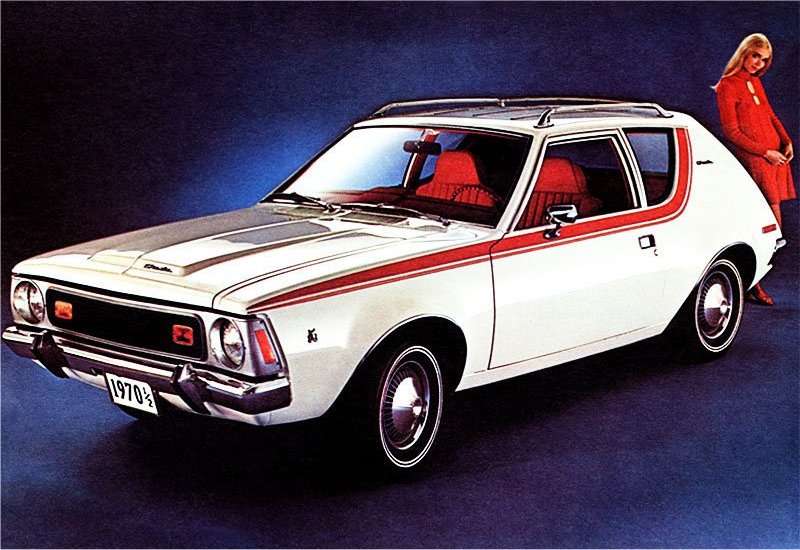The spring of 1970 marked a pivotal moment in American automotive history. While Detroit’s Big Three focused on muscle cars and luxury cruisers, American Motors Corporation (AMC) unveiled a vehicle that would challenge conventional wisdom. On April 1st, 1970, the automotive world witnessed the debut of the AMC Gremlin 199 — a compact car that would redefine American automotive design philosophy.
The timing wasn’t coincidental. As Japanese imports gained traction and fuel efficiency concerns grew, AMC recognized the shifting market dynamics. The Gremlin emerged as America’s answer to the compact car revolution, combining practical dimensions with distinctive styling that set it apart from anything else on the road.
The Birth of an Icon
The Gremlin’s development story reads like a masterclass in automotive innovation under pressure. AMC’s design team, led by Richard Teig, accomplished in 18 months what typically took three years. This accelerated timeline reflected both AMC’s agility and their urgent need to capture the emerging compact car market.
Historical Reference!
Richard Teig's legendary overnight sketch of the Gremlin remains one of the most celebrated moments in automotive design history. Using elements from the AMC Hornet as a foundation, Teig created the initial concept that would evolve into the production model.
«The Gremlin represented everything we needed in American compact cars — efficiency without sacrifice of character,» notes James Morrison, veteran automotive collector with over 40 years of experience. «Its design might have raised eyebrows, but it also raised expectations for what a compact car could be.»
The unconventional name “Gremlin” perfectly matched the car’s personality. Rather than shy away from its unique appearance, AMC embraced it, creating a marketing narrative that turned potential criticisms into selling points.
Engineering Marvel
At the heart of the Gremlin 199 lay a robust powertrain that balanced performance with practicality. The standard 199 cubic inch (3,258 cc) inline-six engine delivered 128 horsepower, while the optional 232 cubic inch (3,802 cc) variant offered enhanced performance for more demanding drivers.
Key technical specifications that defined the Gremlin’s capabilities:
- base engine: 199 cu in straight-six producing 128 hp;
- optional 232 cu in upgrade for enhanced performance;
- three-speed manual transmission as standard;
- rear-wheel drive configuration;
- curb weight of 2,635 pounds (1,195 kg).
«Working on Gremlins today is a joy,» shares Michael Thompson, classic car restoration specialist. «The seven-main-bearing crankshaft design was overengineered for its time, contributing to these engines’ legendary durability.»
Design Philosophy
The Gremlin’s distinctive profile emerged from a bold design philosophy that prioritized functionality while maintaining visual impact. Its 95.98-inch wheelbase and 161.26-inch overall length created a compact footprint without compromising interior space.
Fact!
The Gremlin's unique chopped-tail design saved significant production costs while creating its signature look. This approach reduced the number of body panels needed and simplified assembly.
Early models offered a minimalist two-seat configuration, though later versions included a rear bench seat. This flexibility in configuration demonstrated AMC’s understanding of diverse market needs.
The front disc brakes, measuring 9.02 inches (229 mm), provided reliable stopping power, while the rear drum brakes aligned with period-correct engineering practices.
Legacy and Collection Value
Today’s collector market increasingly recognizes the Gremlin’s historical significance. Low-mileage examples command premium prices, particularly those with documented histories and original components.
«Original Gremlins with the 199 engine represent a unique investment opportunity,» observes Sarah Chen, modern classic car market analyst. «Their value has appreciated steadily over the past decade, especially for well-preserved examples.»
Notice!
Contemporary collectors particularly value first-year (1970) models with original powertrains and documentation. These vehicles often command 30-40% premium over later models.
The Road Ahead
The Gremlin’s influence extends beyond its production years. Its bold approach to compact car design challenged industry conventions and proved that American manufacturers could compete in the small car segment.
Looking back from 2025, we see how the Gremlin’s innovative spirit continues to inspire automotive design. Its legacy lives on in modern compact cars that dare to be different, proving that sometimes the most impactful innovations come from thinking outside the conventional box.
Pros & Cons
| Advantages | Disadvantages |
|---|---|
| Revolutionary compact design pioneering American small car segment | Polarizing aesthetic may not appeal to traditional tastes |
| Robust powertrain with proven reliability | Limited rear passenger space in base configuration |
| Excellent power-to-weight ratio for its class | Fuel efficiency lower than contemporary imports |
| Simple maintenance requirements | Basic interior amenities by modern standards |
| Strong collector value appreciation | Sparse parts availability in current market |
| Historically significant design | Rear visibility challenges due to unique body shape |
The AMC Gremlin 199 represents a fascinating chapter in automotive history where necessity drove innovation. While its unconventional design and compact dimensions challenged contemporary American car traditions, these very characteristics have secured its place in automotive history. For collectors and enthusiasts today, the Gremlin offers a unique combination of historical significance, mechanical simplicity, and investment potential.

